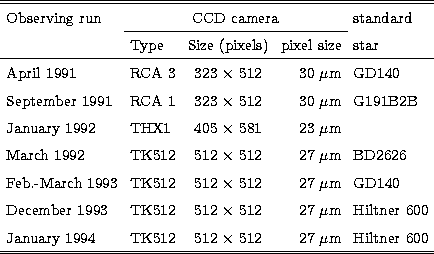The spectroscopic observations were obtained at the 1.93 meter telescope of
Observatoire de Haute-Provence between April 1991 and January 1994. The data
were acquired with the CARELEC spectrograph
(Lemaître et al.1990) and
several types of CCD cameras (see Table 2). The spectral resolution
was 260 Å/mm, which provides a spectral coverage of ![]() Å
with a resolution
Å
with a resolution ![]() 15 Å. The spectra were acquired
under good photometric conditions with a typical seeing between 2 and 3
15 Å. The spectra were acquired
under good photometric conditions with a typical seeing between 2 and 3![]() .
.
During those nights, we also observed various spectrophotometric standard stars (see Table 2) taken from the list given by Massey et al.(1988), except for BD 2626 (Oke & Gunn 1983), in order to flux calibrate the galaxy spectra. He comparison line spectra were obtained immediately before and after the galaxy integration in order to calibrate accurately the wavelength scale. The slit was usually aligned along the bar of the galaxy. For galaxies with multiple nuclei or for pairs of galaxies, we oriented the slit in order to cover the brightest knots.
The observation log is given in Table 3, which gives for each galaxy (Col. 1) the date of observation (Col. 2), the exposure time (Col. 3), the spectral range (Col. 4), the width and position angle of the slit (Cols. 5 and 6). Table 3 is given in electronic form only. During the allocated telescope time, we were able to observe 105 of the 144 galaxies of the sample. The remainder of the paper is based on the data collected for these 105 galaxies.
 |
Table 3:
Log of spectroscopic observations
(available in electronic form only)
Copyright The European Southern Observatory (ESO)